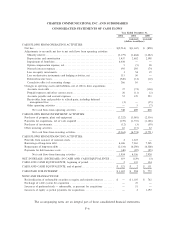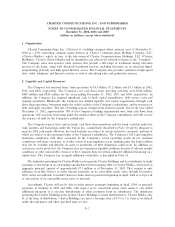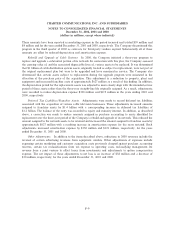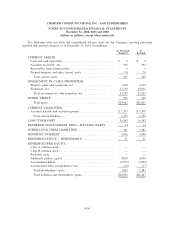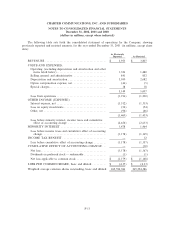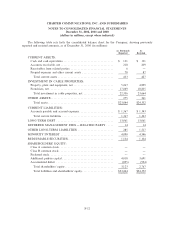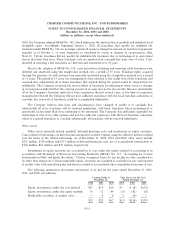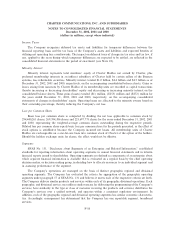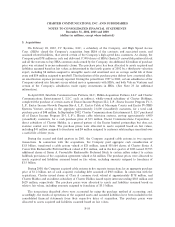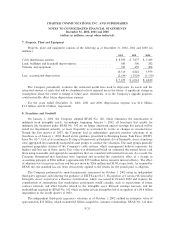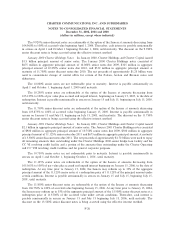Charter 2002 Annual Report Download - page 84
Download and view the complete annual report
Please find page 84 of the 2002 Charter annual report below. You can navigate through the pages in the report by either clicking on the pages listed below, or by using the keyword search tool below to find specific information within the annual report.CHARTER COMMUNICATIONS, INC. AND SUBSIDIARIES
NOTES TO CONSOLIDATED FINANCIAL STATEMENTS
December 31, 2002, 2001 and 2000
(dollars in millions, except where indicated)
Valuation of Property, Plant and Equipment
The Company evaluates the recoverability of property, plant and equipment, for impairment when events
or changes in circumstances indicate that the carrying amount of an asset may not be recoverable. Such events
or changes in circumstances could include such factors as changes in technological advances, Öuctuations in
the fair value of such assets, adverse changes in relationships with local franchise authorities, adverse changes
in market conditions or poor operating results. If a review indicates that the carrying value of such asset is not
recoverable from estimated undiscounted cash Öows, the carrying value of such asset is reduced to its
estimated fair value. While the Company believes that its estimates of future cash Öows are reasonable,
diÅerent assumptions regarding such cash Öows could materially aÅect its evaluations of asset recoverability.
No impairment of property, plant and equipment occurred in 2002, 2001 and 2000.
Derivative Financial Instruments
The Company uses interest rate risk management derivative instruments, such as interest rate swap
agreements, interest rate cap agreements and interest rate collar agreements (collectively referred to herein as
interest rate agreements) as required under the terms of the credit facilities of the Company's subsidiaries.
The Company's policy is to manage interest costs using a mix of Ñxed and variable rate debt. Using interest
rate swap agreements, the Company agrees to exchange, at speciÑed intervals, the diÅerence between Ñxed
and variable interest amounts calculated by reference to an agreed-upon notional principal amount. Interest
rate cap agreements are used to lock in a maximum interest rate should variable rates rise, but enable the
Company to otherwise pay lower market rates. Interest rate collar agreements are used to limit exposure to
and beneÑts from interest rate Öuctuations on variable rate debt to within a certain range of rates. The
Company does not hold or issue any derivative Ñnancial instruments for trading purposes.
Revenue Recognition
Revenues from analog, digital and high-speed data services are recognized when the related services are
provided. Advertising sales are recognized in the period that the advertisements are broadcast. Local
governmental authorities impose franchise fees on the Company ranging up to a federally mandated maximum
of 5% of gross revenues as deÑned in the franchise agreement. Such fees are collected on a monthly basis from
the Company's customers and are periodically remitted to local franchise authorities. Franchise fees collected
and paid are reported as revenues and expenses, respectively.
Programming Costs
The Company has various contracts to obtain analog, digital and premium programming from program
suppliers whose compensation is typically based on a Öat fee per customer. The cost of the right to exhibit
network programming under such arrangements is recorded in operating expenses in the month the
programming is available for exhibition. Programming costs are paid each month based on calculations
performed by the Company and are subject to adjustment based on periodic audits performed by the
programmers. Additionally, certain programming contracts contain launch incentives to be paid by the
programmers. The Company receives these upfront payments related to the promotion and activation of the
programmer's cable television channel and defers recognition of the launch incentives over the life of the
programming agreement as an oÅset to programming expense. This oÅset to programming expense was $57
million, $35 million and $4 million for the years ended December 31, 2002, 2001 and 2000, respectively. Total
programming costs paid to programmers were $1.2 billion, $951 million and $763 million for the years ended
December 31, 2002, 2001 and 2000, respectively. As of December 31, 2002, 2001 and 2000, the deferred
F-16


